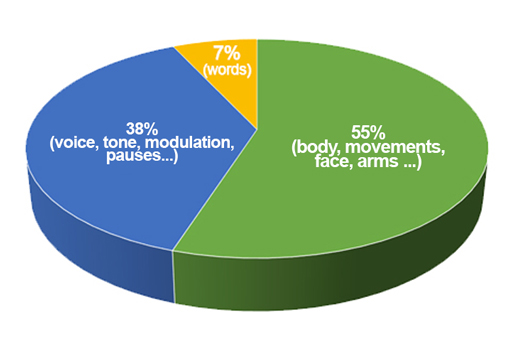1 What is non-verbal communication?
You may not be aware of it, but your non-verbal communication gives away clues about how you are feeling.
Figure 1 illustrates just how significant body language can be when we communicate our feelings. During the 1960s and 1970s, Albert Mehrabian’s work on spoken communication led to the conclusions outlined in the pie chart – figures which are widely quoted in recruitment and business contexts.
It might be a surprise to see that the words you speak only account for 7% of the meaning of your message. Much more important are the tone of your voice (the pauses, etc.) and your body language, including your facial expressions, your gestures and posture.
However, many authors have found fault with these conclusions and Mehrabian himself has explained that:
… this and other equations regarding relative importance of verbal and nonverbal messages were derived from experiments dealing with communications of feelings and attitudes (i.e., like-dislike). Unless a communicator is talking about their feelings or attitudes, these equations are not applicable.
So it is clear that these figures won’t apply in every work situation involving communication, but if feelings or attitudes are involved, such as in a meeting where you feel strongly about a particular issue, they are worth taking into account.
They also help to raise our awareness of the potential significance of non-verbal cues. While the percentages may not always be so striking, it is important to take that aspect of our communication seriously.
In the workplace, understanding non-verbal communication will help you to better manage and understand the feelings of your colleagues and customers. Familiarising yourself with some of the signals or cues you might encounter, will be a helpful process.
Non-verbal cues can also contribute to hasty judgements about others. Being aware of how you react to someone’s clothing, gestures or other non-verbal cues will help you to focus on the message being delivered rather than being distracted by an inappropriate outfit or lack of eye contact.
Activity 1 Identifying non-verbal cues
Non-verbal signals are in all of our everyday conversations, from formal meetings to informal chats.
Make a list of any non-verbal signals you can think of. Think about your own cues or the ones you see others use when you communicate with them. Remember they can include body language, facial expressions or even pitch and tone of voice.
Discussion
Negative cues might include:
- repeatedly looking at a phone, checking a watch or looking out of the window
- shaking the head or frowning
- slouching in the chair.
Positive cues might include:
- slightly raised eyebrows or nodding
- mirroring the gestures of the speaker
- leaning forward slightly in the chair.
If you can pick up these cues in your everyday conversations, you’ll gain an advantage in understanding how your contributions are being received.

